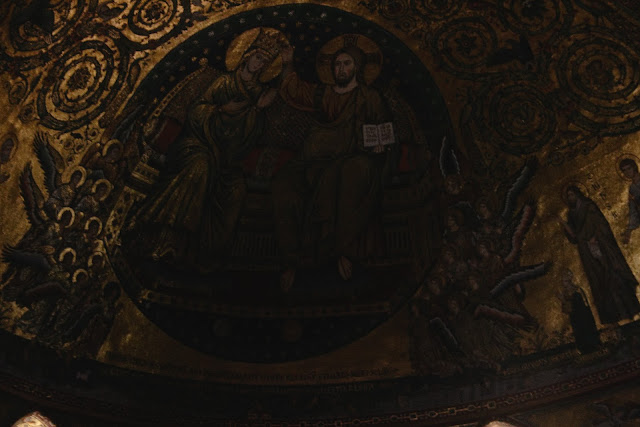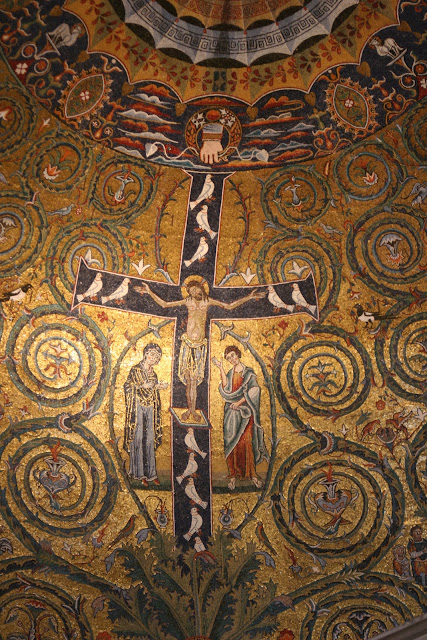I started off by going on the Via Appia Antica, aka the Appian Way. The road was first used in the 4th century BC, and it connects Rome to southeast Italy. Parts of it are the original Roman road, and shockingly, you are allowed to drive on it (a testament to Roman building techniques, I suppose). There are some pretty interesting ruins and beautiful views along the way, too:
I walked along for a bit, until I came to the Basilica di San Lorenzo, originally built by Constantine in the 4th century, although heavily modified over the years. The church itself is nice...
...but I was really there for what's underneath. Some of the oldest Christian catacombs in Rome are beneath this basilica. There are three levels, with the highest being the oldest, but you can really only explore level 2; the others are too dangerous, although there are a couple areas that you're allowed to go into. You are also required to go with a guide; normally this would bug me (I'd much prefer to just do it on my own. Go figure, from the guy who's on a month-long trip by himself), but I could easily see how you could get lost down there, or potentially hurt yourself, particularly if you happen to be prone to claustrophobia. There are a variety of fairly average grave sites (at one time over 100,000 people were buried here), as well as a few special ones, such as the tombs of St. Lawrence, St. Peter, and St Paul (all of whom have been moved), and 3 pagan mausoleums which are believed to have been the original burials in the area. I wasn't allowed to take pictures, but above ground they had a few of the Christian sarcophagi on display, all from the 4th century:
Even if these catacombs are a bit out of the way, they should be at the top of the list for visitors to Rome. Not impressive in the same way that the Coliseum is, but fantastic nonetheless.
Afterwards, I started walking up the Appian Way back towards Rome, and went to the Chiesa di Domine Quo Vadis. According to tradition, Peter was fleeing Rome ahead of his imminent execution when he saw a vision of Jesus, walking towards Rome. He asked Him "Domine, quo vadis?" meaning "Lord, where are you going?" Jesus responded that he was going to Rome to be crucified again. Peter got the message and turned around to face his death, by upside-down crucifixion (at his own request; he felt unworthy of dying in the same manner as Jesus, so he had the Romans turn his cross upside-down). The church marks the spot where this event was believed to have taken place, complete with a piece of marble with the supposed footprints of Jesus embedded:
After this, I tried to go to the Basilica di San Lorenzo Fuori le Mura. I say tried, because the attempt was a pretty spectacular failure. First I couldn't figure out the buses to get there, then when I finally did there was Mass going on, and then I couldn't figure out the buses going back. All in all I probably wasted about 2 hours. I plan on trying again (now that I have a better idea of where I'm going), but in the meantime here's a picture of the outside:
Next up was the Basilica di San Paolo Fuori le Mura, in a totally different part of town ("fuori le mura" just means "outside the walls"). The original church dates back to the 4th century, but there was a massive fire in the early 19th century and much was destroyed (although not the apse mosaics; I'll get to those in a minute). No expense was spared in the reconstruction, and you can tell:
 |
| This place is BIG. Like fit-most-other-churches-inside-of-it big |
 |
| Triumphal arch mosaics |
 |
| The apse |
The mosaics are one of the few things to survive the fire, although to call them original is a stretch (various "restorations" have been performed over the years). There is a much higher level of detail in these mosaics than the Byzantine ones I've seen thus far (mostly noticeable in facial features), and I think that this is a result of restorations made over the years as well as the sheer scale. I thought that San Giovanni in Laterano must have been the second largest church in Rome after St. Peter's, but now I think the distinction probably has to go to St. Paul's
To finish out my day, I tried to go to Santi Giovanni e Paolo, fairly close to the Circus Maximus and Coliseum. Once again I say tried, because when I got there I ran into a wedding. Like San Lorenzo this is a pretty important stop for me, so I'll be trying again (presumably there won't be weddings on Mondays, but I'm afraid I'm setting myself up for an incredibly hectic day). Here's a shot of the outside for now:
Feeling rather defeated, I called it a day after this. Tomorrow I'll be attending Mass in the morning (I think at SS. Cosma e Damiano, near the forum), and then trying to get into as many churches as possible that are left on my list. I'm hoping that the Masses will be mainly in the morning (they usually are), so that after lunch I should be able to see quite a few. At least I hope so, because if not Monday will be busy, busy, busy. Wish me luck!

























































